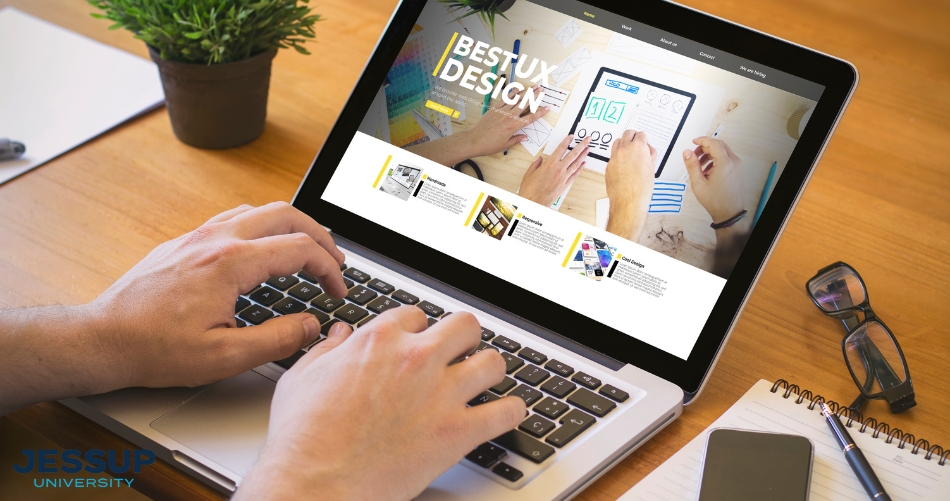The Relevance of User Experience in Reliable Web Design Approaches
User experience (UX) works as a keystone in efficient web design techniques. It forms exactly how customers engage with a website, affecting their contentment and likelihood of returning. A well-designed UX can enhance involvement via intuitive navigating and responsive layouts. Nevertheless, forgeting these aspects may lead to frustration and raised bounce rates. Recognizing the details of UX is crucial for developers aiming to produce engaging electronic experiences that reverberate with varied audiences. What elements really drive successful user engagement?
Comprehending User Experience and Its Effect on Design
Although user experience (UX) is typically perceived as a plain aspect of web design, it basically forms just how individuals connect with a website. UX includes all elements of the user's interaction, including use, access, and general satisfaction. A favorable UX promotes engagement, urging customers to check out the website and return in the future. Alternatively, an adverse experience can result in stress, leading to high bounce rates and lost opportunities for conversion.
Design components like material, navigating, and layout organization play important duties fit this experience. Efficient UX layout expects user requirements and preferences, ensuring that information is conveniently accessible and visually enticing. Additionally, recognizing user behavior with analytics can provide beneficial insights, notifying design choices that improve usability. Eventually, a complete understanding of UX allows designers to produce web sites that not only bring in users but also promote significant interactions that straighten with company objectives and user expectations.
Key Principles of Reliable User Experience
Efficient user experience pivots on a number of vital principles that boost internet site capability and involvement. Intuitive navigating layout, receptive design essentials, and the significance of aesthetic pecking order are important components that contribute to a seamless communication between users and web material. Understanding these concepts enables developers to create more straightforward and accessible electronic atmospheres.
Intuitive Navigation Design
When customers encounter a website, intuitive navigating layout works as an essential portal to their overall experience. Efficient navigation allows customers to effortlessly situate the details they look for, improving their interaction with the site. Trick principles include clear labeling, sensible organization, and regular positioning of navigation components. Labels should be simple, permitting individuals to predict the content they will discover. A well-structured pecking order helps customers recognize the connection between different areas, guiding them with the website seamlessly. In addition, responsive food selections and conveniently available links add to a fluid experience throughout gadgets. By prioritizing instinctive navigating, designers can substantially decrease user stress and rise involvement, ultimately cultivating a positive assumption of the internet site and its web content.
Receptive Layout Basics
A well-structured navigation system naturally results in the demand for a responsive format, which is crucial in today's diverse digital landscape. A receptive layout guarantees that websites feature effortlessly throughout different tools, consisting of desktop computers, smartphones, and tablets. This versatility boosts user experience by allowing content to be quickly available and visually meaningful, no matter display dimension. Trick concepts of responsive layout consist of liquid grids, adaptable pictures, and media queries, which promote suitable watching. In addition, prioritizing touch-friendly aspects improves communication on smart phones. By executing a responsive format, designers can accommodate customers' requirements, lessen bounce rates, and rise engagement. Eventually, a well-executed receptive design promotes a positive user experience, motivating site visitors to discover the website additionally.
Aesthetic Hierarchy Significance
Visual hierarchy plays a vital duty in assisting individuals with a web site, making sure that vital information catches their interest. By tactically making use of size, spacing, shade, and comparison, designers can develop a clear pathway for individuals to follow. Larger elements often attract the eye, indicating their relevance, while contrasting shades can highlight contact us to action. In addition, consistent alignment and collection of associated material enhance comprehension, making navigating user-friendly. Effective use visual power structure not just improves functionality yet likewise supports the overall aesthetic of the website, fostering a favorable user experience. When users can conveniently determine one of the most crucial information, they are most likely to engage with the web content, resulting in increased fulfillment and communication with the site.
The Function of Usability in Web Design
Functionality plays a crucial duty in web design, specifically with navigating simpleness and adherence to access standards. Effective navigating improves user fulfillment by enabling visitors to discover details swiftly and with ease. Meeting accessibility standards assures that all customers, regardless of their capabilities, can efficiently connect with the internet site.
Navigation Simplicity
Simplicity in navigation stands as a foundation of efficient web design, greatly affecting user experience. A structured navigating system allows individuals to find details swiftly and without effort, lowering aggravation and enhancing fulfillment. Clear labeling and rational structure are essential components, directing individuals effortlessly with the web site. Redundant links or overly complex menus can confuse individuals, resulting in boosted bounce prices. Additionally, mobile responsiveness should be considered, making certain navigating continues to be straightforward throughout gadgets. Minimizing and prioritizing necessary web pages mess even more sustains user interaction. Reliable navigation not just promotes a favorable experience yet likewise motivates users to discover the site much more completely, ultimately resulting in greater conversion prices. Hereof, navigating simpleness functions as an important factor in the general effectiveness of web design approaches.
Access Specifications
User engagement is considerably boosted when web sites stick to availability standards, ensuring that all individuals, no matter their capabilities, can navigate and interact successfully. Compliance with these standards not only broadens the audience but likewise boosts total user fulfillment. Accessible style incorporates functions such as message choices for images, key-board navigation, and sufficient color comparison, which assist in use by people with disabilities. Additionally, carrying out these criteria can favorably impact search engine optimization (SEARCH ENGINE OPTIMIZATION) by improving site framework and clearness. As web design evolves, prioritizing accessibility ends up being important in promoting an inclusive digital environment. By accepting these requirements, designers add to an extra equitable web, ultimately driving user commitment and involvement.
Relevance of Responsive Layout for User Interaction
As customers significantly accessibility web sites through a Visit This Link range of gadgets, the importance of responsive style becomes critical for involving users properly. Responsive layout warranties that a site adjusts flawlessly to different screen dimensions, supplying an optimal viewing experience regardless of the device made use of. This flexibility boosts user involvement by helping with much easier navigating and communication with content.
When individuals experience an internet site that is responsive, they are most likely to stay much longer, discover better, and return in the future. A properly designed receptive layout reduces the stress typically connected with zooming and scrolling on smaller sized screens, consequently lowering bounce rates. Additionally, receptive style can positively impact online search engine positions, as internet search engine focus on mobile-friendly web sites. In today's digital landscape, where mobile usage remains to rise, executing receptive design is not just valuable, however important for maintaining user involvement and guaranteeing a positive experience throughout all gadgets.
Enhancing Load Times for Better User Fulfillment

To enhance load times, internet designers must prioritize enhancing photos, leveraging internet browser caching, and decreasing HTTP demands. Furthermore, utilizing Material Delivery Networks (CDNs) can expedite content shipment by distributing it throughout different geographic areas. Streamlining code, such as pressing CSS and JavaScript data, even more adds to faster loading rates.
Ultimately, a dedication to improving lots times not only improves user fulfillment however also enhances brand commitment and boosts the likelihood of repeat gos to. A swift, seamless experience is essential for maintaining customers and cultivating positive interactions.
The Impact of Visual Hierarchy on User Interaction
Visual hierarchy serves as a necessary element in leading user communication on a website. By organizing web content in a manner that prioritizes information aesthetically, developers can influence exactly how customers navigate and involve with a website. This YOURURL.com power structure is established through various layout techniques, including dimension, color, spacing, and comparison. Larger fonts or strong colors attract attention to essential elements, such as calls to activity or headings, while controlled colors and smaller sized fonts can indicate subordinate info.
Reliable visual power structure aids users promptly identify what is essential, decreasing cognitive load and boosting use. It allows for intuitive navigation, making it simpler for customers to locate what they need without frustration. As users engage with a site, a well-structured aesthetic power structure cultivates a more gratifying experience, inevitably bring about higher involvement and conversion rates. Designers need to focus on these concepts to produce an user-centered and efficient web atmosphere.
Determining User Experience: Tools and Methods

Regularly Asked Inquiries
Just How Can I Boost My Web site's User Experience on a Budget plan?
To improve an internet site's user experience on a budget, one can maximize web page tons rate, streamline navigation, carry out receptive layout, boost material quality, and gather user comments for constant improvements, making certain a satisfying visitor experience.
What Are Typical User Experience Blunders to Stay Clear Of in Web Design?
Typical user experience blunders in web design consist read more of chaotic formats, bad navigating, sluggish packing times, absence of mobile responsiveness, disregarding availability, inconsistent branding, and stopping working to focus on user feedback - Website Design Agency. Each can considerably hinder overall website performance
Exactly how Often Should I Update My Web Site for Better User Experience?
Internet sites need to be updated frequently, ideally every few months, to keep optimal user experience. Constant updates assist address functionality problems, refresh material, and adjust to transforming user requirements, making certain the site remains relevant and interesting.

Can User Experience Impact SEO Rankings on My Internet site?
User experience can greatly influence SEO positions, as search engines prioritize web sites that use smooth navigating, quick packing times, and engaging web content. A positive user experience can result in reduced bounce prices and higher search exposure.
What Role Does Access Play in User Experience Layout?
Ease of access plays an essential role in user experience layout by making sure that all people, no matter of capacities, can engage and navigate with a web site efficiently. This inclusivity enhances total complete satisfaction and engagement among diverse customers.
User experience (UX) is typically viewed as a simple facet of web design, it basically shapes how individuals engage with a website. User engagement is considerably boosted when websites stick to accessibility standards, guaranteeing that all individuals, regardless of their capacities, can navigate and communicate efficiently. Gauging user experience (UX) is important for comprehending exactly how efficiently a website meets the demands of its individuals. Furthermore, use testing, where real customers navigate the site while observers keep in mind troubles, supplies direct feedback on user experience. Common user experience mistakes in internet design consist of messy layouts, poor navigating, slow packing times, absence of mobile responsiveness, neglecting accessibility, irregular branding, and falling short to focus on user comments.